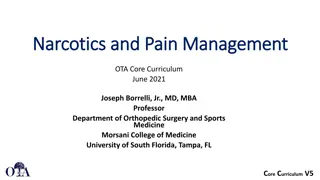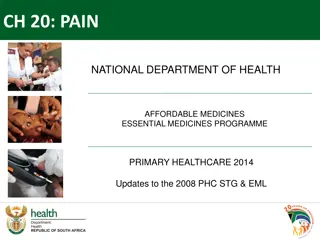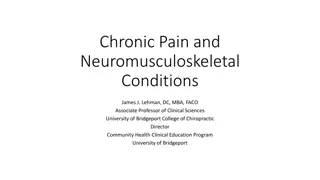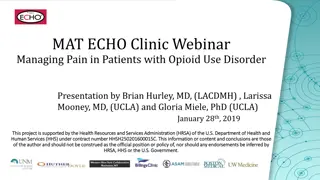Understanding Low Back Pain: Causes, Epidemiology, and Management
Low back pain is a prevalent issue affecting adults globally, with lumbar disc disease and poor posture being significant contributors. This condition can result from various factors, leading to discomfort in the lower back region. Understanding the epidemiology, common and uncommon causes, as well as the structures involved, is crucial for effective management and prevention of back pain.
Download Presentation

Please find below an Image/Link to download the presentation.
The content on the website is provided AS IS for your information and personal use only. It may not be sold, licensed, or shared on other websites without obtaining consent from the author. Download presentation by click this link. If you encounter any issues during the download, it is possible that the publisher has removed the file from their server.
E N D
Presentation Transcript
LOW BACK PAIN LOW BACK PAIN Dr. Dileep Kumar MS (Ortho) Assistant Professor
INTRODUCTION Low back pain is a very common problem and has a ubiquitous distribution. The most common cause of LBP is lumber disc disease. Bad posture plays a very significant role in the genesis of LBP. LBP refers to pain from the low lumber areas, lumbosacral areas and both the sacroileac joint.
Low back pain is an extremely common malady affecting the human race across globe. It is a price mankind has to pay for their upright posture
Epidemiology 60 90% of adults experience back pain at some point in their life. - incidence age 35- 55 yr. - 90% resolve in 6 weeks. - 7% become chronic. - M/F equally affected. 5thLeading reason for medical visits.
Normal posture of spine Moderate cervical and lumber spine. lordosis of Kyphosis of the thorasic and sacrococcygeal section. Forward pelvic inclination of 30 degree. Neutral rotation og femur.
Pathophysiology Physiologic curves give the spine its S shape. If due to our posture this S curve fails to maintain, muscles attach to spine starts to ratain posture by contraction. Repeated contraction of muscle causes fatigue and strain in ligaments articulating faces and pain starts over back. and posterior
Common causes of backache Unaccustomed activities Poor posture Occupational backache Obesity Muscle strain Prolapsed lumbar intervertebral disc The facet joint arthritis Spinal stenosis Osteoporosis/Osteomalacia
Uncommon causes of backache Spina bifida Lumber scoliosis Tuberculosis Ankylosing spondylitis Neoplastic diseases affecting spine Pain referred from viscera Spondylolysis Spondylolisthesis
Structures Involved in Backache Vertebral bodies Intervertebral disc Posterior intervertebral joint Ligaments and small intervertebral muscles Posterior longitudinal ligament Nerves
Disc Herniation Physiology Tears in the annulus. Herniation pulposus. of nucleus
Disc Herniation Physiology Compression nerve foramen leads to pain. of in the the root Lumber disc prolapse most commonly occurs in L4-5 vertebral level.
Level of disc prolapse and nerve root compression Pain Radiation Sensory loss Disc prolapse between Motor loss L3 and L4 (L4 nerve root involve) Lumber region Along the antero- medial aspect of thigh Lateral thigh, leg, dorsum of the foot and 1sttoe Buttocks, posterior thigh,leg and lateral foot Medial shin Quadriceps Knee jerk- Normal L4 and L5 (L5 nerve root is involve) Lumber region, groin, Sacroiliac region Lumber region, groin, Sacroiliac region 1sttoe area Extensor hallucis muscle Medial hamstrings Redused L5 and S1 Lateral foot Grastrocne- Ankle jerk Reduced mius
Easy way to remember L4 nerve root involvement- 4 heads of Quadriceps. Hence knee jerk affected. L5 nerve root involvement- 5 toes- Great toe and lateral 4 toes lose extension. S1 nerve root involvement- A of Tendo-Achilles. Hence, ankle jerk lost.
Disc Degeneration Physiology With repeated efforts, the lower lumbar discs lose their height and water content ( bone on bone ) age and Abnormal between the bones leads to pain. motion
FEATURES OF PAIN LOCATION - The pain may be located in the lower middle or upper back . Disc prolapse and degenerative spondylitis occur in the lower lumbar spine. Infection and trauma occur in the dorso lumbar spine.
ONSET- Often there is a history of significant trauma immediately preceding the onset of the back pain. LOCALISATION OF THE PAIN- A pain arising from the tendon or muscle injury is localized whereas that originating from the deeper structures is diffuse.
PROGRESS OF PAIN In traumatic and in acute disc prolapse the pain is maximum at onset and then gradually subsides. The back pain due to disc prolapse often has periods of remission and exacerbations, an arthritic pain is more constant.
RELIEVING OR AGGRAVATING FACTORS Most back pains are worsened by activity and relieved by taking rest. Pain due to ankylosing spondylitis and sero negative arthritis are typically worse after taking rest, and improve with activity. A pain initiated on walking or standing and relieved by rest is a feature of spinal stenosis. An increase in pain during menstrual period indicates gynaecological pathology.
SPASM-Muscle spasm may be present in acute back pain and can be assess by the prominence of the para vertebral muscles at rest which stand out on the slightest movement. TENDERNESS-Localized indicate a ligament or muscle tear. Pain originating from the sacro iliac joint may have tenderness localized to the posterior superior iliac spine. tenderness may be SWELLING-A cold indicating tuberculosis as the cause. abscess may be present,
Assosiated symptoms STIFFNESS- Associated with most painful backs but it is a prominent symptom in pain due to ankylosing spondylitis, more in early morning. PAIN IN OTHER JOINTS- In Rheumatic diseases. RADICULOPATHY- Pain in distribution of the sciatic nerve. Generally occurs due to disk herniation. Also called as Sciatica.
EXTRA history suggestive of abdominal complaints, urogenital complaints complaints may indicate an extra skeletal cause of pain. SKELETAL SYMPTOMS- A or gynecological THE PSYCHOLOGICAL STATUS- of the patient must be judged to rule out hysteria or malingering as a cause of back pain.
Physical examination 1) STANDING POSITION POSITION Normally a person stands erect with the center of the occiput in the line with the two shoulders are at the same level, the lumbar hollows are symmetrical and the pelvis is square. In case of back pain look for scoliosis, kyphosis, lordosis, pelvic tilt, and forward flexion of the lower limbs.
Range of movement Flexion- 80 degree Lateral flexion-35 degree Extension-20-30 degree Rotation- 45 degree
2) Lying down position Straight leg raising test Peripheral pulses Adjacent joints An abdominal rectal or per vaginal examination
STRAIGHT LEG RAISE TEST STRAIGHT LEG RAISE TEST The straight leg raise test is positive if pain in the distribution reproduced 30 and 70 passive flexion of the straight leg. Dorsiflexion of the foot exacerbates the pain. sciatic is between
Modifications of SLRT Lasegue s test Buckling s sign Sicard s test Fajersztajn s test
INVESTIGATIONS The diagnosis of back pain is essentially clinical. There is no use of getting x-rays done in acute back pain less than 3 weeks duration. There are number of other investigations like CT scan, MRI, bone scan, blood investigations etc.
BLOOD INVESTIGATIONS These should be carried out in case if one suspects malignancy, metabolic disorders, or chronic infections.
RADIOLOGICAL EXAMINATION Routine x rays of the lumbo-sacral spine and pelvis should be done in all cases. Though x-rays are usually normal in non specific back pain these provide a base line. It shows bony pathology.
Abdomen, X-ray, Anteroposterior View 1. 1st Lumbar vertebra 2. 2nd Lumbar vertebra 3. 3rd Lumbar vertebra 4. 4th Lumbar vertebra 5. 5th Lumbar vertebra 6. T12 7. Twelfth rib 8. Sacroiliac joint 9. Sacrum 10. Sacral foramen 11. Ilium 12. Pelvic brim 13.Superior ramus of pubic bone 14. Pubic symphysis
MRI/CT MRI-To rule out soft tissue pathology or nerve root compression. CT- To rule out mainly bony pathology.
Bone scan- It may be helpful if a benign or malignant bone tumor is suspected on clinical examination but is not seen on plain x rays. Electromyography- To rule out nerve root compression. Discography
TREATMENT Conditions for treatment-An unremitting backache not cured by simple treatment methods. A backache with pain radiation to legs. Sensory compromise. Bladder and bowel disturbances. Severe backache and severe restrictions of spine. Backache due to spine deformities, infections, trauma, ankylosing spondylitis, malignancy etc. rheumatoid diseases ,
Most back pain fall in non specific category have a set of program of treatment mostly conservative. It consists of rest, drug, hot packs, spinal exercises, traction corset, education regarding prevention of back pain etc.
DRUGS Drugs like pain killers, muscle relaxants, anti depressants, calcium supplements, vitamin supplements and very rarely steroids. Local application of the ointment and gel are also widely recommended. Drugs are however not safe for long periods.
PHYSIOTHERAPY This is an important method of treatment and may be used to support the drug treatment or during post surgical recovery. There are various recommended physiotherapy methods of treatment.
HEAT THERAPY Heat helps to increase the blood circulation to the skin muscles, bones and joints. Increased blood supply takes away the pain producing sustains from the tissues and rids patient of the pain. E.g. hot water packs and infrared rays.
COLD THERAPY It consists of ice packs, ice massage, cold water packs etc. It is very effective if used within 24 hrs. of an acute injury of the back. After 24-48 hrs. one can switch over to heat therapy
MASSAGE This has been a very common method of treatment since ages. It is a popular method and if done skillfully it provides a soothing effect and induces relaxation of spine muscles and ligaments.
Pelvic traction This method involves applying pulling forces over the muscles, ligaments and joints with the help of appropriate pulling devices. This induces relaxation of the muscles and ligaments, separates the bones and joints and thus helps to reduce pain and muscle spasm. It ensures complete bed rest too.
ADJUVANT METHODS LUMBO SACRAL CORSETS They are useful in acute stages of low back pain and also act as a psychological boost. However it weakens the spine if used for prolong period as the back muscles tend to get weakened due to inactivity. It negates the advantages gained by the way of exercises which actually strengthens back muscles.
EXERCISES OF THE BACK Exercises serve the role of putting spine back to its normal shape. They are aimed to strengthen posterior spinal muscles, abdominal muscles and thigh (quadriceps) muscles. To tone the other muscles of the trunk.
GENERAL INSTRUCTIONS Do exercises on a hard floor Do all exercises at least five repetition each time slowly increase it to ten Be well relaxed and at ease Use well fitting clothes Keep breathing rhythmically If it increase pain abandon it If possible do exercises in company.
EXERCISES RECOMMENDED FOR BACK ABDOMINAL MUSCLE EXERCISES 1. Head raising exercises 2. Straight leg raising exercises 3. Knees to chest exercises 4. Abdominal flexion to toe touch 5. Rotational exercises
Exercises of trunk hip and thigh muscles 1) Hip extension 2) Trunk flexion 3) Quadriceps exercises 4) Hamstring stretch exercises 5) Back extensor muscles exercises

























